Artist Talk – Carey Newman

Ideation – 3 Brainstorms
Goal: highlight the role that temporary migrant workers play in our community and economy. Celebrate them and cast them as heros, not as slaves.
Means of doing so:
- Amplify the work that is being done out there already. Amplify the voice of a poet or another artist that is from this field and draw awareness and attention to them while joining in the dialogue
- Find other artists
- Photographs
- Poems
- Songs
- Direct action to solutions as part of a CTA
- My petition
- Other migrant right workers websites
- Materials could use:
- 3D printing of plywood or cardboard?
- Painting
- Drawing
- Video Art
- Plaster
- Sewn mesh
- Collaging
- A combination of any of these
- IDEA 1: Virtual Reality: As part of my work with Professor Tony Trudel, develop a virtual farm where class mates can interact avatar farm workers and learn about their stories and their work as temporary foreign workers. The intention is to create an educational environment that brings people closer to those experiencing the injustices of contemporary forms of slavery. In addition, this space can highlight the back breaking work and the fantastic contribution from these workers. They can also learn more about the stories of immigrants and build empathy with this cause.
- IDEA 2: Engagement Activity: Facilitated Discussion: Go beyond the visual and connect people with the emotions, explore what people can do and how they can personally connect to this issue. The intention is to create a deeper connection with this cause. Moving beyond the mere informational, we dive into the personal stories of one another and learn how each of us are connected to this work. Further consideration would be needed to explore how to format such an engagement. I’m thinking probably we sit in a group and there are dialogue prompts to start the conversation or “ice breakers” of some sort. Careful consideration to create a safe environment for people to share would be required.
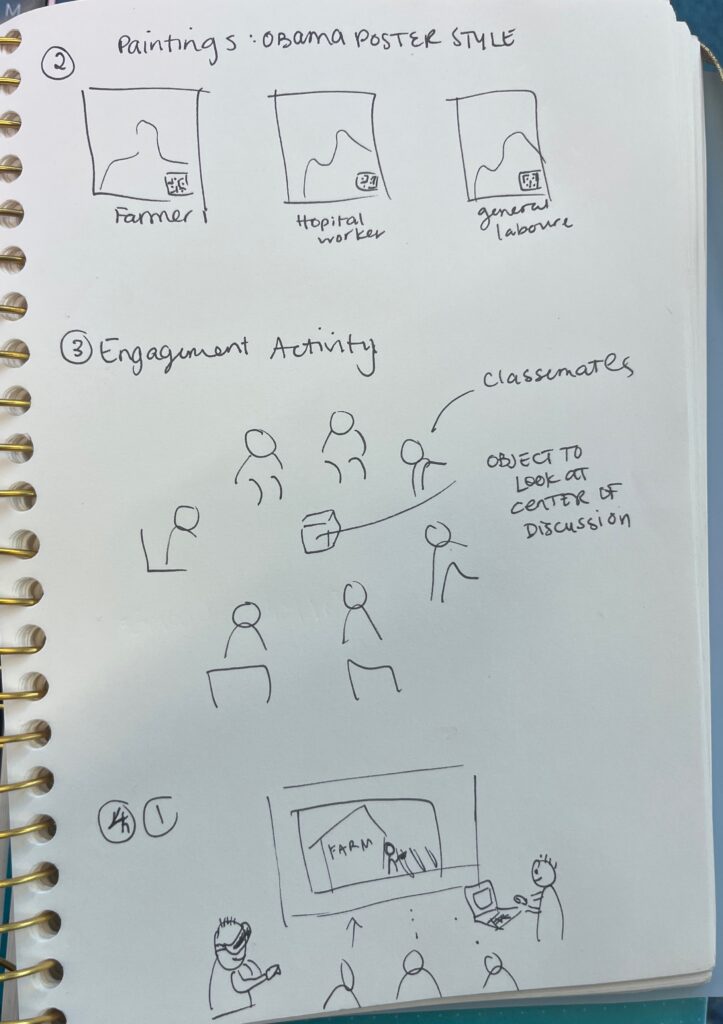
- IDEA 3: 3 Panel Artwork linked with QR Code: Create a 3 paintings that feature an Obama-style political poster art meaning to highlight the work of farm workers as the true heros of our time. Provide a QR code as a call to action and place to learn more. The intention is to highlight people who’s contribution is truly building up our country. Instead of featuring politicians, the poster highlights the every-day people who are critical for our way of life. This is a flip! Instead of propping up the already visible politicians, who in Canada are actually making life more challenging for every day people, we are propping up the invisible migrant population who are really behind the incredible services that make up our identity: farmers, hospital workers, neighbours, etc.

Artist Research – Shepard Fairey
- Where were they born? Where did they grow up? Where do they live now:
- Born Feb 15 1970, American, Fairey currently lives and works in Los Angeles, CA
- Founder of Obey Art Series
- middle-class teenager, Fairey had an interest in skateboard culture. By 1984 he was designing and selling hand-decorated boards and T-shirts.
- Where did they study art? Or are they self-taught?
- graduated from the Rhode Island School of Design in 1992 where he earned his Bachelor of Arts in illustration.
- What kind of art do they make?
- Graphic art; street art
- Looking at the one selected artwork
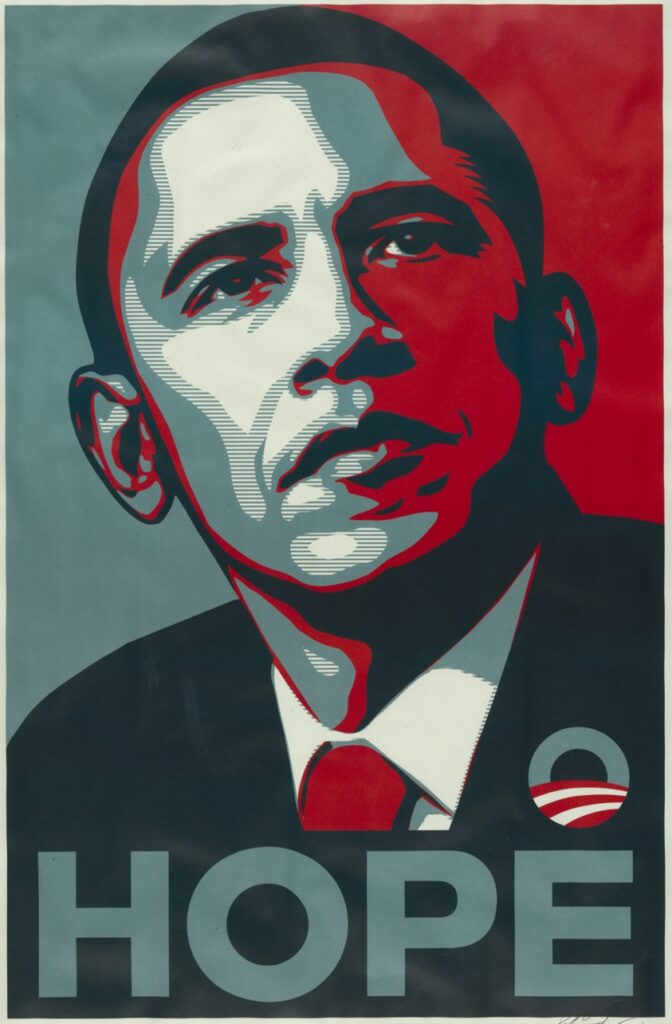
Barack Obama “Hope” Poster, 2009Shepard Fairey
Color lithograph on white wove paper
86 × 61 cm (36 × 24 in.)
- What are the formal aspects of their work (size, colour, materials, texture, value, composition, genre, style, etc)?
- based the work on an Associated Press photograph by Mannie Garcia,
- high-contrast stencil technique, inspired by the political message and bold graphics of Soviet Socialist Realism
- featuring reds and blues that complement the campaign logo designed by Sol Sender
- How do these formal aspects affect how you “read” the artwork?
- Idealized political propaganda style
- Patriotic colours
- Imagery of Obama “looking upwards” creates a sense of forward movement, possibility
- Iconographic style immortalizes Obama
- What materials and methods might she be using to make these works?
- I imagine it was created using a digital art tool which allowed Fairey to manipulate the colours of the image by Mannie Garcia.
- Then, it might have been printed or screen printed onto poster paper
- What is the context for this work (when this work was produced, what is going on politically, theoretically/philosophically, in the art world, in their personal life)?
- This artwork was produced as a tool for the Obama presidential campaign in 2008
- At the time, Obama would be the first black president in the history of the united states
- At this point Fairey was already well known for is “Andre the Giant has a posse” stickers and Obey line and had a developed style which he was using for political activism
- What emotions does the work elicit for you?
- Having the word “hope” right in the image does elicit the emotion
- Feelings of pride and patriotism
- The gaze and dress of the figure gives a feeling of: focused, determined, attentive, civilized
- What ideas does the work cultivate, or questions does the work ask you to consider?
- What is the imagery of a leader?
- What qualities doe we want to see in a leader?
- How does hope play a role in our selection of a presidential leader?
- How does emotion and imagery play into our selection of a presidential candidate?
- What does the artist say about their own work?
- “Art is not always meant to be decorative or soothing, in fact, it can create uncomfortable conversations and stimulate uncomfortable emotions”
- “I wanted strong. I wanted wise, but not intimidating,”
- …… What other questions about this artist or their work do you have?
- It’s interesting to note that Fairey was sued by the photographer for using this imagery. They were able to settle the dispute outside of court, but it did raise questions around copywrite law. This is something to keep in mind for my artwork as well.
- My question in relation to this, is if you buy a photographic image off of a platform like shutterstock, are you aloud to manipulate or alter the image and make money off of it? Or does this require a different kind of agreement?
- Is there anything about this artist’s work that interests you? What and why? If not, can you articulate why that is? What is missing for you?
- I like the simplicity of the artwork and it’s use as a political tool
- The use of a word to depict meaning and suggest emotion, which is especially useful in street art where an artist statement or artistic intention statement isn’t available
- I also like how quickly the artist was able to create this image. Being able to make art fast, especially for political statements, can be a great tool.
- Is there anything about this artist’s work that you can carry over into your own art practice? What in particular?
- This does inspire inspire me to learn how to use digital art platforms
- The use of colour to mimic politicial campaigns
- Include the links to the websites you obtained your research from.
- https://www.artnet.com/artists/shepard-fairey/
- https://www.artic.edu/artworks/229396/barack-obama-hope-poster
- https://www.artsy.net/artist-series/shepard-fairey-obey-barack-obama
- https://www.britannica.com/biography/Shepard-Fairey
Process
Stage 1: Creating the frame, measuring out the plywood peices, transfering images to plywood
After considering all my options an my timeline, I decided to go with the plywood box structure. To get started, I knew I needed to talk to Jeff since I had very little experience with capentry. I asked him if he could help me put together my box and he explained how to make the structure. Together, we measured and cut the wood. The measurements, as you likely know, are very important to get right. And at this point in my design I was still planning on doing all 3 sides of the structure with light coming from the imagery. Given the size of the wood we were using to make the structure, we had to leave space at the top and the bottom that would not have any cutting so that light could emerge from the full figure (not just 2 inches from the top and bottom of the figure).
We also considered adding wood in the corners to help with the structure, but ultimately decided that the piece could be held up by the plywood panels themselves, to avoid any further loss of the image due to obstruction from the wood.
After putting together the top and bottom frame of the box, I decided to work on the outline for the images. To save time, I used Nim’s projector and cast the images I’d selected onto the plywood surface. These two tasks took several hours to complete.
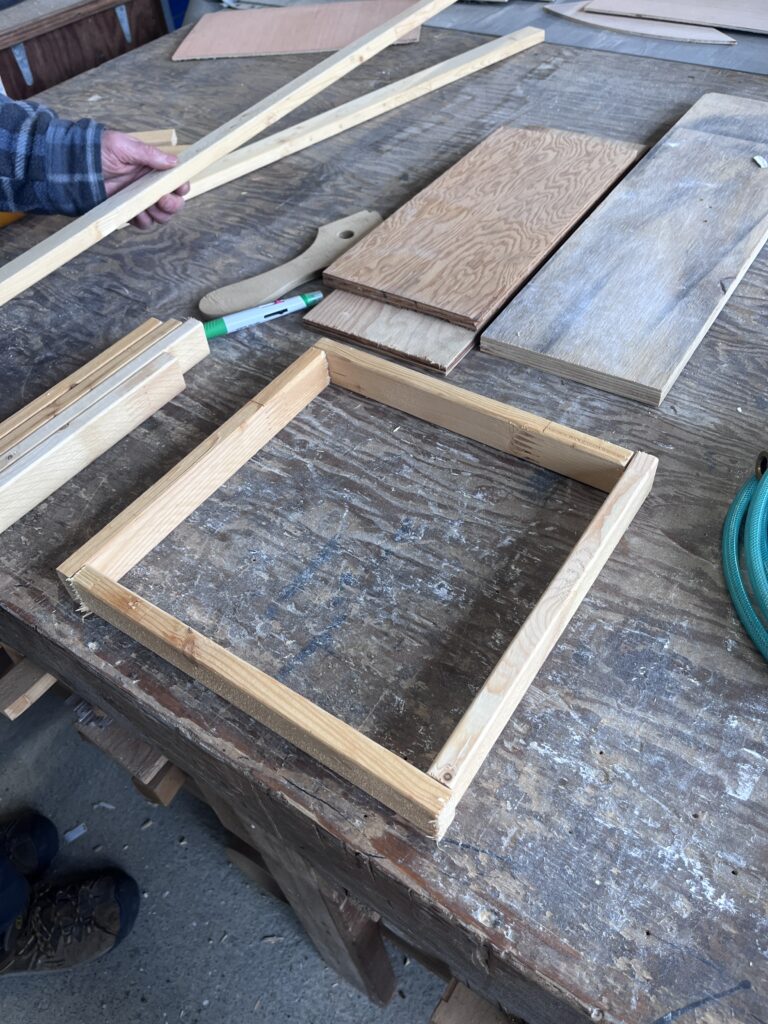
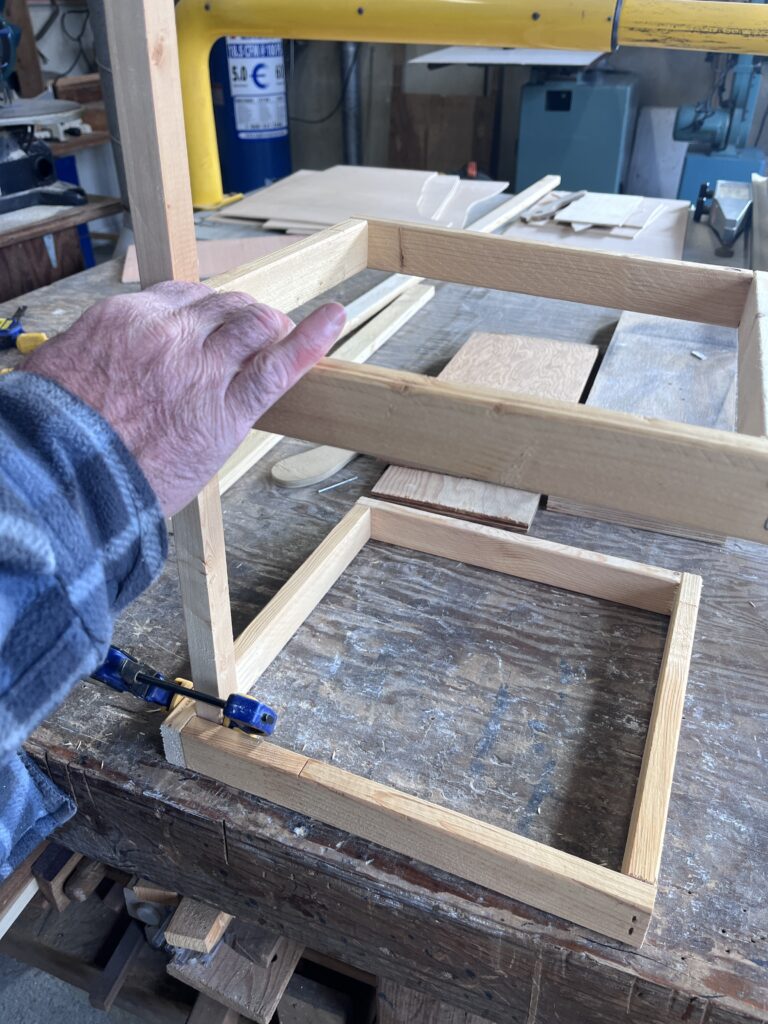
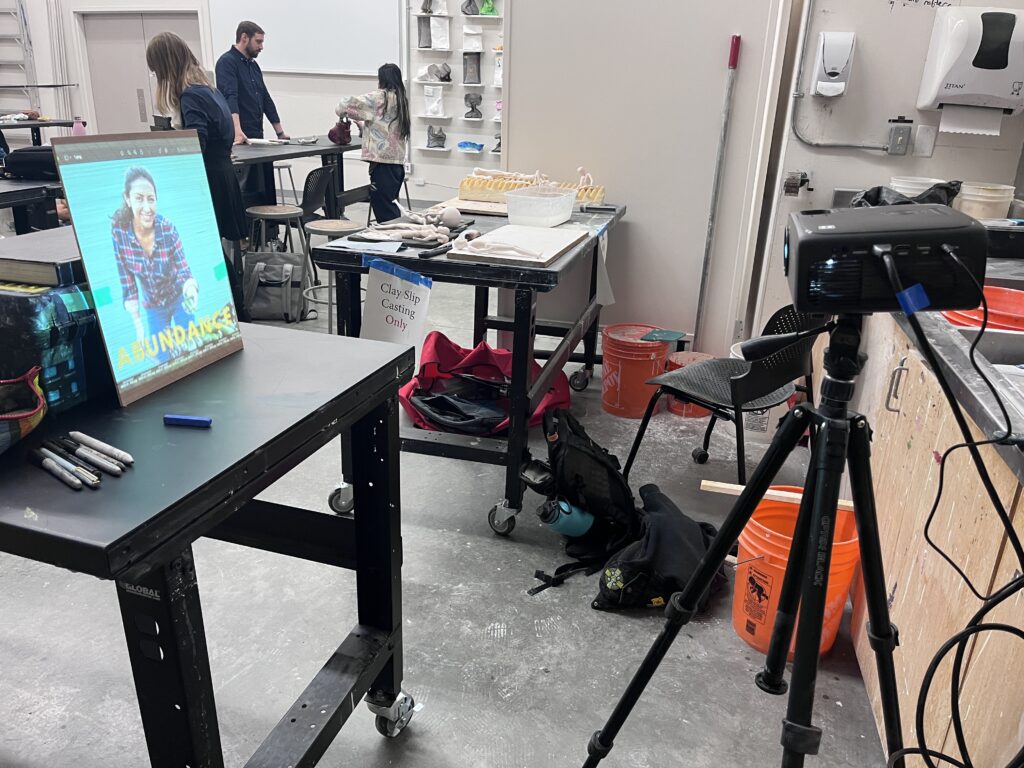
Stage 2: Testing cutting tools & scroll sawing the plywood
Althought I don’t have any image of my test plywood here, I can’t stress enough how important it was to test out my materials before going to cutting. Again, with wood and cutting, there really is no going back. So, I was fortunate to practice ahead of time with a spare piece of plywood. Here is where I learned that I wasn’t going to be able to use the engraving tip of a Dremmel tool. The engraving tool is made for, well engraving, not cutting through plywood and I quickly found out that the tool was entremely difficutle to maneuver and if I was going to try and cut all the way through the plywood so that light could come through, then I was going to get very thick and sloppy lines. That just wouldn’t do. So, I went to home depot to see if I could find any cutting attachments from the Dremmel. I bought two attachments and before the end of the night I returned them. The first was about an inch in size for cutting wood, and the other was 1/4 inch for cutting metal/diamond. Both of these ended up cutting the wood but the lines were too long, I just wouldn’t be able to cut the lines around the face or smaller details of the fingers. It wouldn’t do. So, I started investigating alternatives.
I considered getting it lazer cut, and contacted the MakeItZone. I knew my chances were slim given the short turn around time. So, I thought about moving to paper and using a cricut. But this would require at least a $50 investment and moving to paper. There is a cricut that can cut wood, but a vaneer wood not plywood, and these cricuts cost upwards of $450. I just wasn’t willing to fork that out. So, I considered the scroll saw, or just painting my panels and skipping the cutting all together. So, I emailed Jeff to see about the scroll saw and the next day I spoke to him about how to go about cutting with the scroll saw.
Jeff showed me how I could cut the lines of the figure without having to cut into the shape from the side of the plywood. This would require drilling small holes into each line, then detaching the blade of the scroll saw, placing the plywood, then reattaching the scroll saw blade for every single line. It would be labour intensive, but it worked and I got beautifully thin and maneuverable lines. I will admit, to detach and re-attach the blad of the scroll saw I needed to squat below the saw to pinch the blade on the bottom and this ended up giving me a heft work out. My legs were sore for days from squatting and standing so many times. Who knew I’d get a work out too!
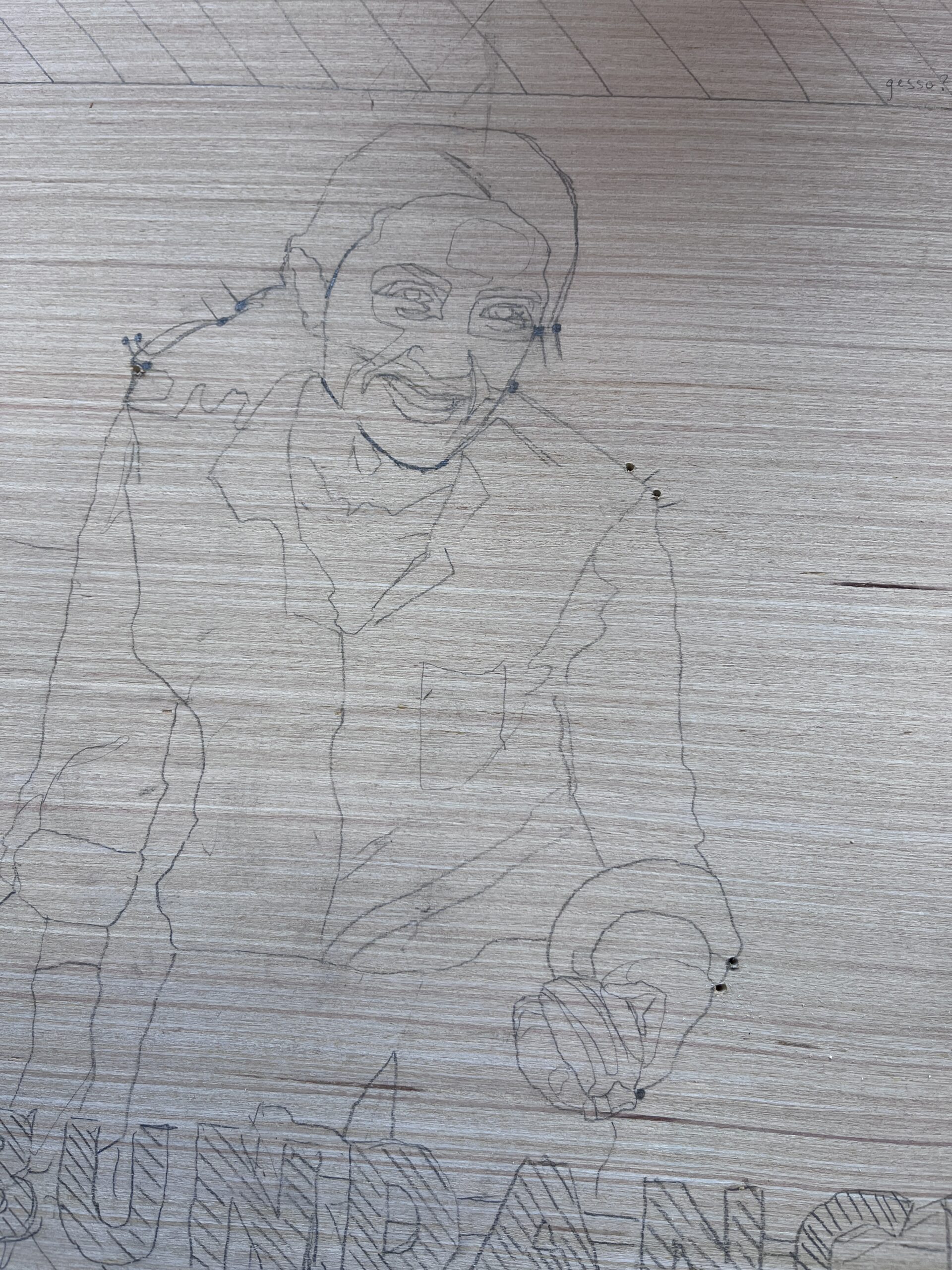
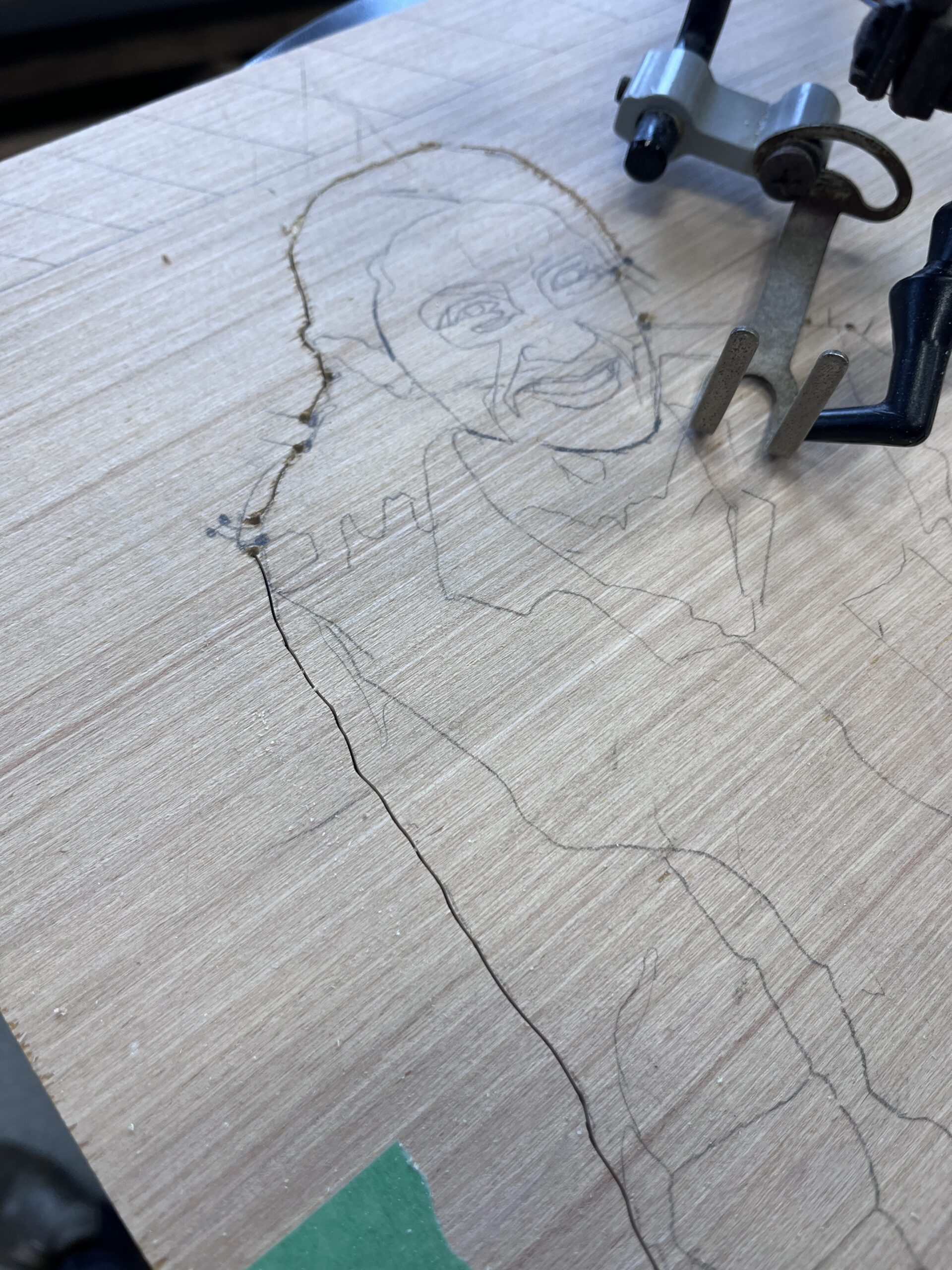
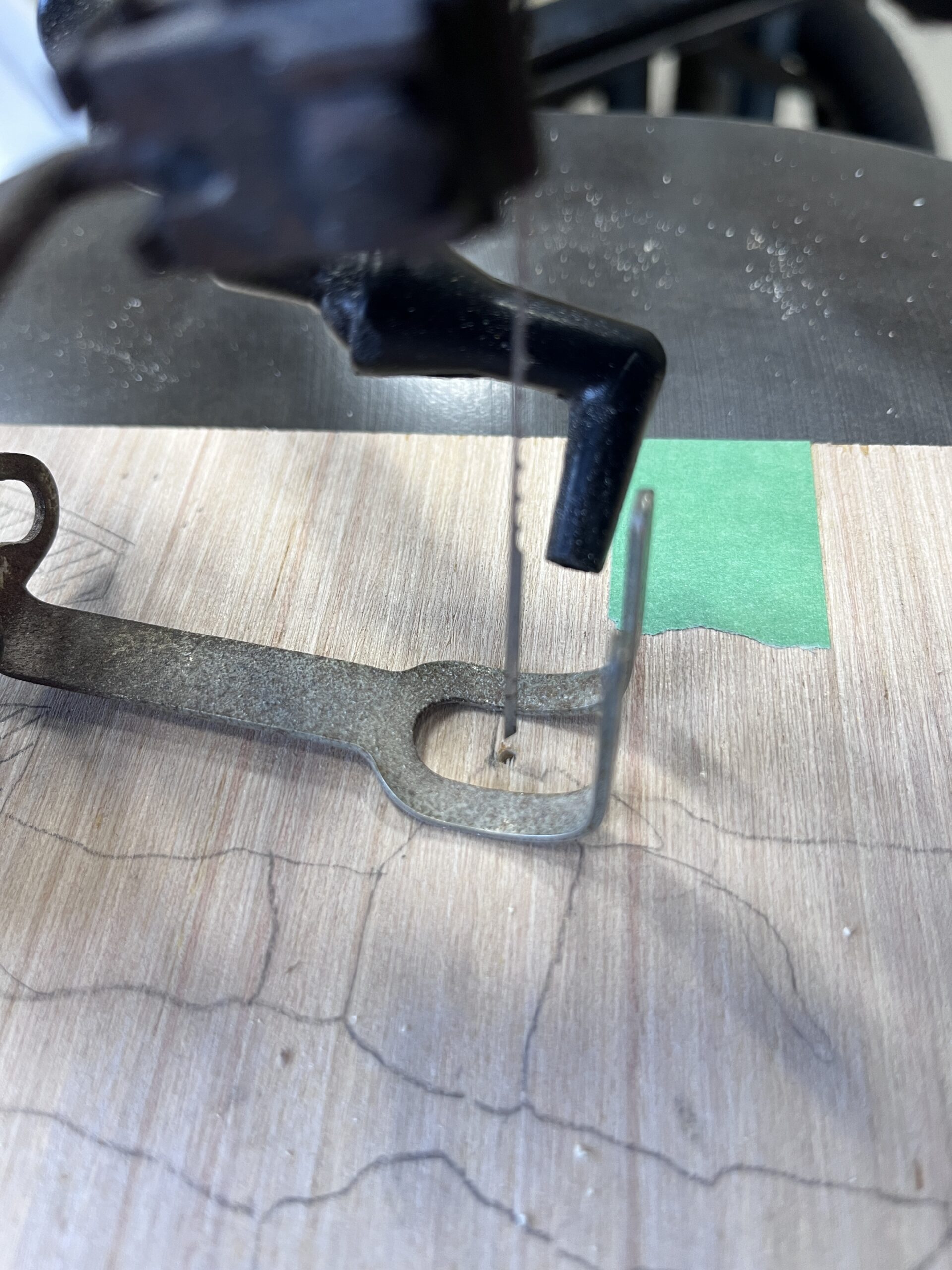
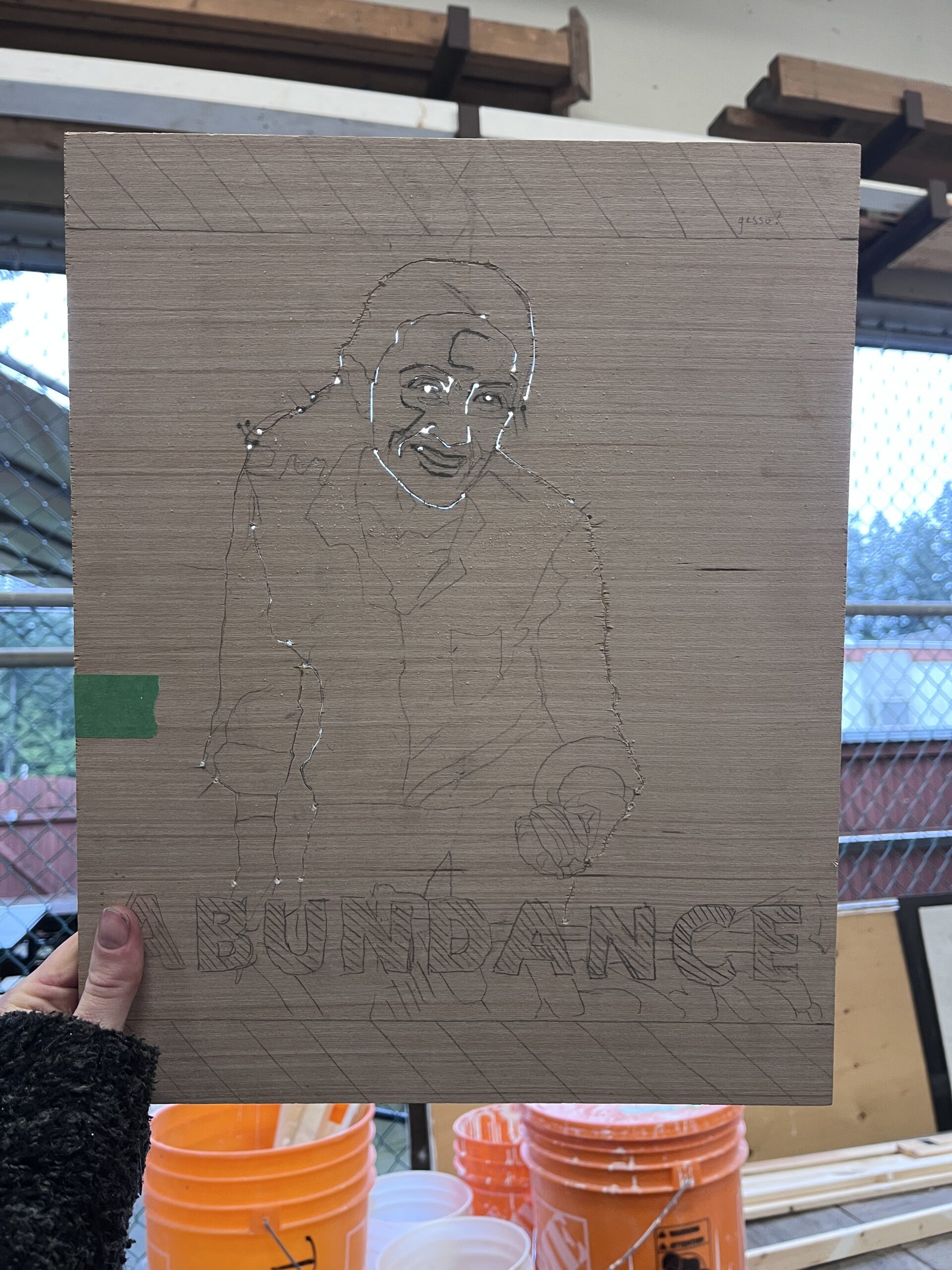
Stage 3: Painting the Plywood
Now that my plywood cutting was well on its way I had a more accurate depiction of how long this would take. Since I needed to detach and reatach the blade so many times, I knew I wasn’t going to be able to complete all 3 sides of the box. So, I decided I would paint two sides and only do one panel illuminated. I figured this might work out better because it would be hard to paint the cut edges without the paint getting into the cuts and preventing the light from coming through. In addition, the light coming through the lines might distort or prevent the colours from being seen on the panel. This way I could create the “obama like” poster while also getting at least one illuminated image.
I went ahead and prepped the plywood for painting with a clear gesso (pictured below). This was my first time using Gesso, and I realized later that once the gesso was down, I wouldn’t be able to erase any of the pencil line work below. That was a bit unfortunate because once I got to the painting there were a few edits I wanted to make. But I had to swallow those mistakes and go with what was drawn.
To decide on what colours to use I had my colour wheel handy. I wanted to go with an almost complimentary colour combo – eg. purple and orange, and green and purple, to really make the images pop. The Obama poster used blue/green and red so I wanted to use a similar complimentary scheme.
It was definitely difficult for my brain to translate value to colour schemes and I probably got some revered in areas. But I did alter the colours in the reference images to a “duotone” filter to help my eye determe which areas should be which colour. This definitely helped.
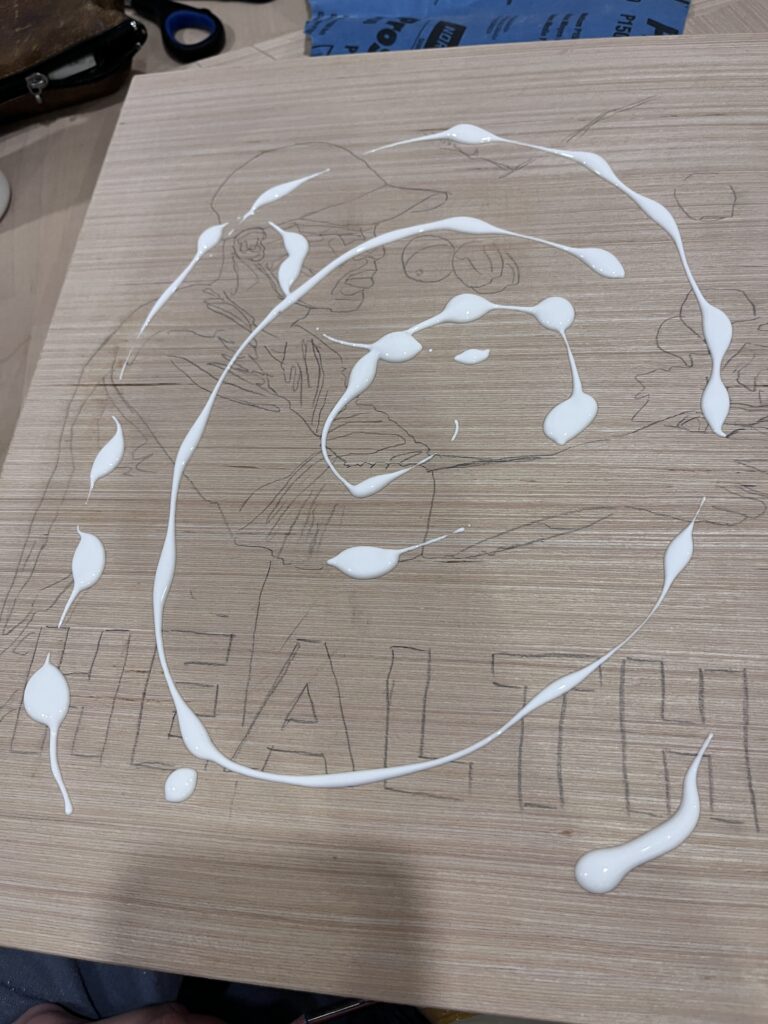

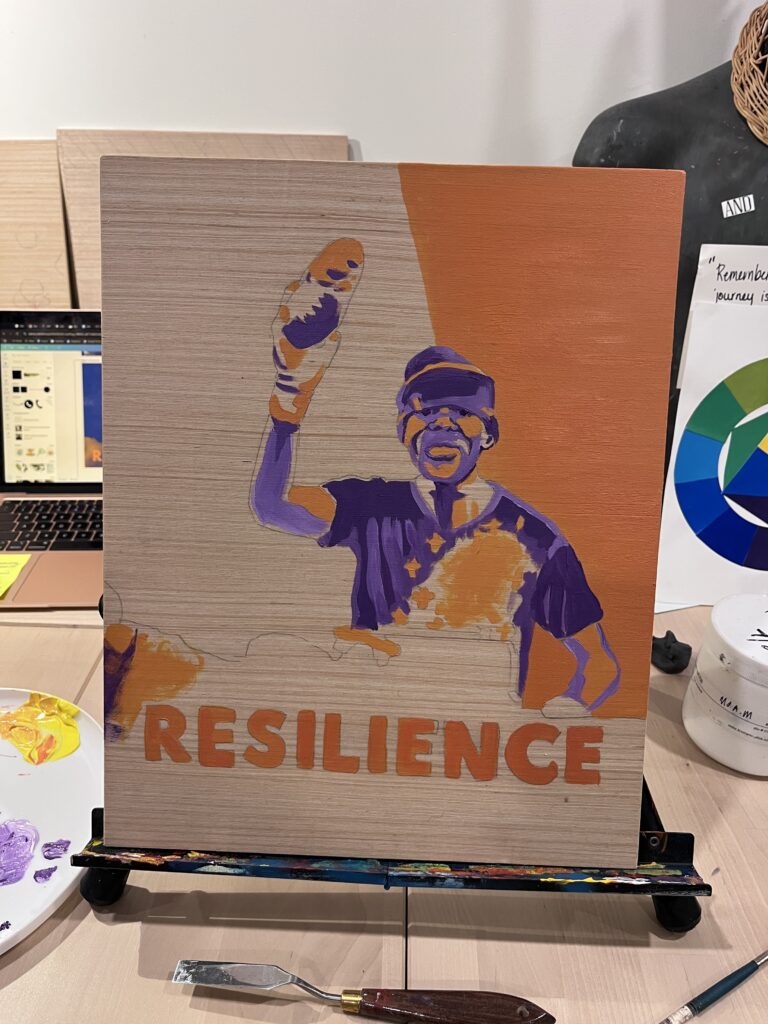

Final Artwork Documentation
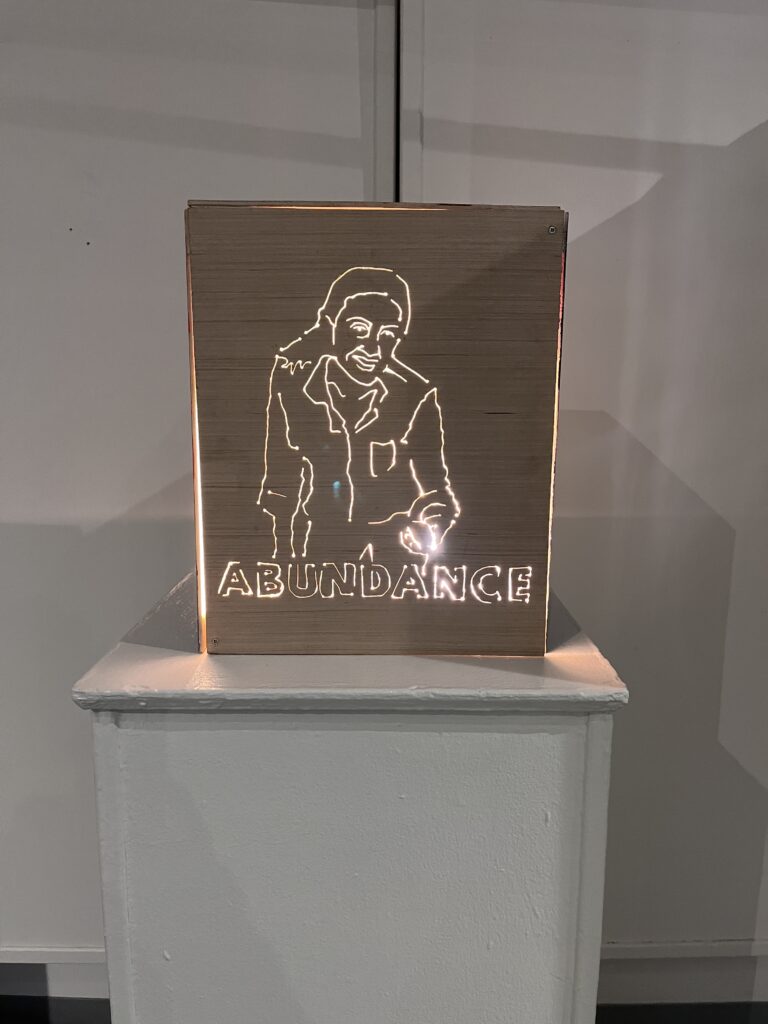
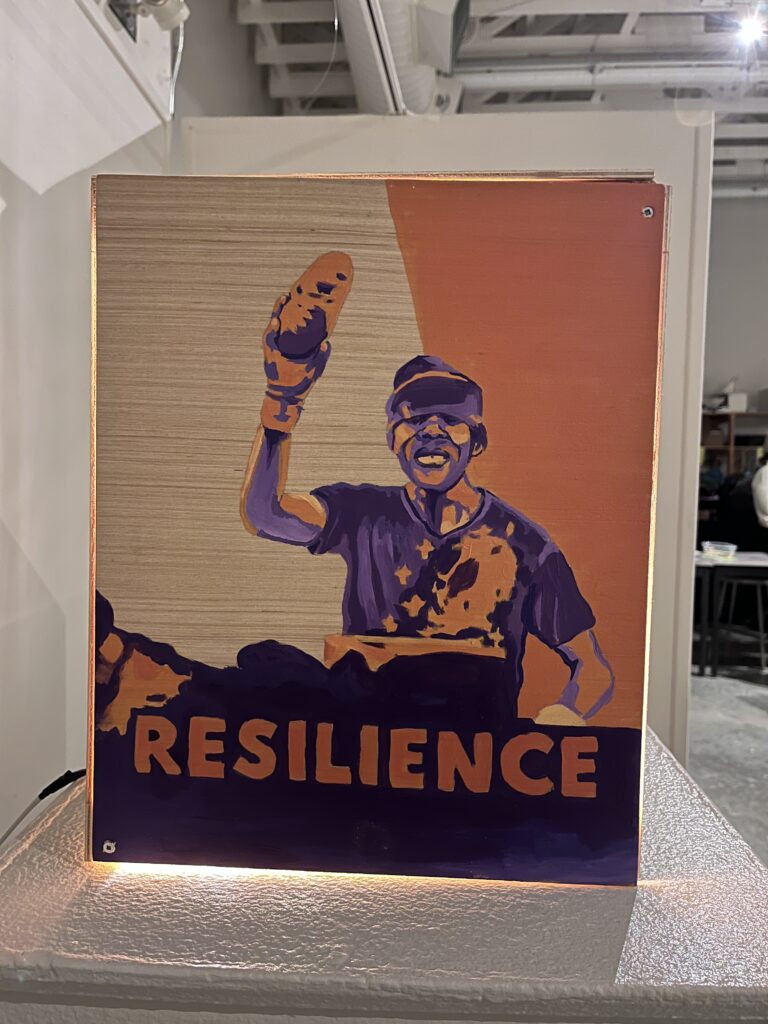
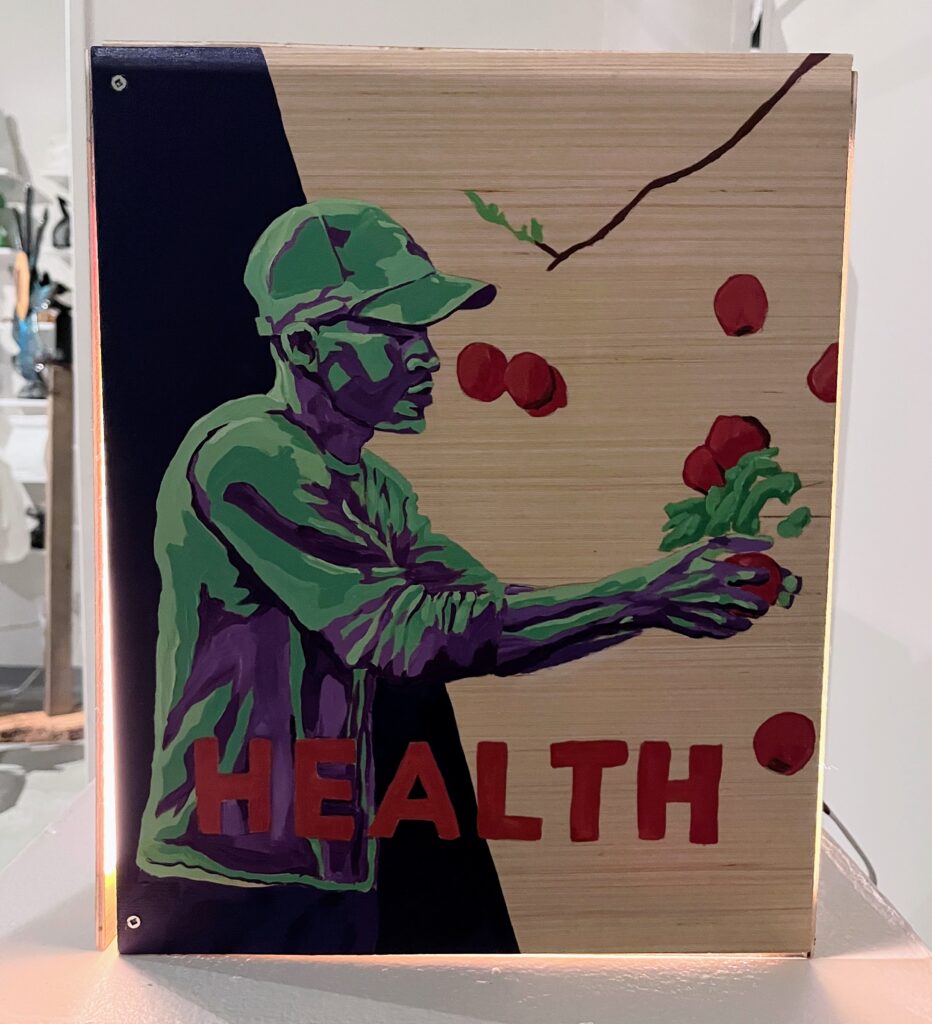
Truth Revealed
Arielle Houghton
Acrylic on Plywood, 2024
Intention Statement
The intention of this artwork is to show temporary foreign farm workers in a more positive light than what is currently being portrayed by the media and Trudeau Liberals. I wanted to celebrate the people who work so hard to put food on our tables. The work is made on plywood, with one panel cut with a scroll saw. The other two sides of the piece are painted in an “Obama Hope” style with acrylic. If I had more time I would have scroll sawed the images of the workers on all three sides of the plywood box to better illuminate all three images. To save time, I would like to explore utilizing a laser cutter from the MakeItSpace in Courtenay. Another consideration to explore is painting all three sides with the light illuminating the linework. However, I’d like to testing this with a simpler image first to see fi the light and colour would complement one another, or conflict by creating a poor quality back-lit image that is difficult to see.
Draft Artist Statement
Free write:
The artwork is about the way we put people in a box, and how behind those images, whether idealic or limiting, is the light from within the box, the true essence and offering of each individual. In particular this artwork focusing on the way we put migrant farmworking into this limitation of who and what they are. The burden they create in society and the way that we are to “deal” with that problem. Right now in Canada, the government is making drastic cuts to permanent residency and temporary foreign worker permits. While doing so the Liberals are blaming these workers for the housing crisis, inflation, and steep tuition costs. However changing work permits and further limiting access to permanent residency does not address any of these issues. Rather the political narrative is to scapegoat those often marginalized members of our society.
This artwork is the second iteration of an earlier work that attempted to draw attention to the recent UN Report on Contemporary forms of slavery, its causes and consequences by ____. The report revealed human rights infringements on temporary foreign workers among other populations in Canada and how the Canadian government can address these atrocities. In my earlier work I focused on the depiction of slavery as a bold attempt to move the viewer to act by signing a petition. In this iteration I wanted to focus more on the beauty of immigrants in Canada, honing in on farmer workers and they role in providing food to our society.
Each image depicts a farm worker harvesting a fruit or vegetable. Each piece is depicted on a piece of plywood and communicates a word which I chose in relation to the food being harvested. On one side, you see a farmer worker painting in acrylic holding up a potato with the word RESILIENCE. On the other side, also in acrylic, is a farmer harvesting apples. Here the word HEALTH is depicted. On the 3rd side of the plywood box is a farmer holding a Zucchini. Here we see the word abundance. But the 3rd farmer is not painting. Rather she is lit from behind and light escapes in lines which illuminate her form and the lettering. Light also escapes from the edges of the box, as if light is bursting from the seams.
In this way the work focusing on highlighting all that migrant farm workers offer: abundance, health and resilience to Canadian society. They are the light behind many of privileges afforded to those who live, eat, and grow in so-called Canada.
Artist Statement – Brainstorm
list of adjectives that describe your work.
- Illuminating
- Colourful
- Celebratory
- Proud
- Engaged
Emotions and reactions that you have to the work:
Hunger. Desire. Outrage. Positive Action. Hope. Pride. Gratitude. Expansion.
Write a casual letter to your best friend:
Dear Kelsey. Remember how I left you that super long voice message crying about how Canada treats migrant workers? Well, I decided that one art project wasn’ enough. This time I wanted to celebrate the incredible work of farm workers who make up the majority of temporary foreign workers, with hope to help people see just how important they are to our way of life. I spent a lot of time on the scroll saw trying to cut the lines of a form into plywood. So muchn so that my legs are sore from squatting so many times to detach and re-attached the blade of the scroll saw so as to separate each line on the plywood and prevent the whole image from falling out of the plywood background. Unfortunately this took so long that the other sides of the boxes are painting in an Obama-Style poster image featuring words like “hope” that I think capture the spirit of the farm workers: like “resilience, Health and abundance”. I’m pretty happy with how it turned out. Despite the short timeline. I hope you like it too!
Jeopardy your practice. What are the questions you hope to answer in your work?
- What is the value of temporary foreign workers?
- How to farm workers benefit Canadians?
- What foods do we have thanks to the labour of temporary foreign workers?
- What do you wish people would see about farm workers?
WHAT – WHY – HOW STRUCTURE
- WHAT – The Key Idea: a sentence about what you are doing – don’t keep the reader in suspense!: In this plywood box-shaped structure, farm workers are depicted offering the fruits of their labour; the foods we eat. On one side the view sees a working holding a zucchini and the word abundance, on another side a potatoes and the word resilience and finally apples and the word health. The farms are scene in an
- WHY – the context for the work, and/or the initial inspiration. This information should help explain why you create your work: The work is intended to case a light on all that temporary foreign workers and migrants offer Canadian society. The piece focused on farm workers, who make up the majority of temporary foreign workers. Currently the common political rhetoric is that migrants are the cause of contemporary issues such as the housing crisis, the high cost of education, and job shortages. This work attempts to offer an alternative view and illuminate the fruits of migrant labour.
- HOW – research: For my research on this piece I reached out to local migrant rights networks, read the 2024 Report from the United Nations on Contemporary Forms of Slavery it’s causes and consequences which highlighted the issues being faced by Temporary Foreign workers in Canada. In addition, I researched about the recent changes to immigration policy by the Canadian Government under the Trudeau Liberals. Finally, I wanted to look deeper into the history of the struggle of farm workers in North America, so I also researched information on the Farm Workers movement in the USA (and Canada)?
- CONCLUDING SENTENCE: This work aims to illuminate the true heroes behind a Canada we know and love – the farm workers who put food on our table.
Artist Statement
In this plywood box-shaped artwork, farm workers are depicted offering the fruits of their labour; the foods we eat. The work is intended to illuminate the benefit of migrant workers in Canada. In particular, the piece focused on highlighting farm workers, who make up the majority of temporary foreign workers.
The current rhetoric in Canada is dominated by the narrative that migrants are the cause of contemporary issues such as the housing crisis, high cost of post-secondary education, and job shortages. This work attempts to offer an alternative view; it is Canada who is exploiting migrants. It does so by reflected those workers in the same style as the political propaganda imagery used during the 2008 election created by artist Shepard Fairey depicting Obama with the word “hope” written below. In doing so, the viewer sees migrant workers in a positive light, similar to how politicians are idealized in during election campaigns.
This artwork is inherently political and was inspired by recent media on the UN Report which exposes Canada for its role in creating contemporary forms of slavery. I was inspired by this report and it’s offering of a buffet of solutions to the abuse of migrant workers. Drawing from my own experience as a community organizer, my organizing practice largely comes from the Farm Workers, Civil Rights and Labour Movements in the USA which was studied and packaged as an educational tool by Harvard Professor Marshall Ganz. In addition to drawing from my personal experience, I researched local migrant networks and organization offering more information on the recent changes to immigration policy by the Canadian Government
This work aims to shed light on the true heroes behind the Canada we know and love – a place where people of all backgrounds can come together and enjoy the abundance of the land around good food.


